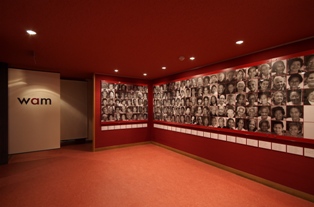Justice to the “comfort women” survivors
By Mina Watanabe

Women’s Active Museum (WAM) celebrated its 5th anniversary in August 2010. It is a huge step for us and in the Japanese women’s movement to stop violence against women during conflict and in daily life. We are deeply committed to this cause and will continue our activities till we achieve our purpose.
Let me introduce you a bit about WAM. The project was proposed by the late Yayori Matsui, who was respected journalist in Japan. Matsui was devoted to women’s issues and also believed deeply in justice and equality for all. The vision behind the project is to take up the fight on behalf of the survivors of Japan’s military sexual slavery system, which was organized wherever the Japanese military invaded in the 1930s till Japan was defeated by the Allied Powers ending World War ll in 1945. It is said that 200000 women and girls were victimized, but there are no correct figures for the number, because many of the survivors has passed away by now, and we suspect that many of them have not spoken out due to the discrimination they face from their societies.
The huge problem was the denial of the facts itself in Japan. The government, at the beginning, refused to accept it’s involvement to establishing the “comfort station” system itself, and the cry for justice by the survivors, when their stories were first reported. The national mood was one of ridicule and the survivors were treated as “prostitutes”. This infuriated many survivors and us, as women living in perpetrating country, and we started to build a campaign, joining hands with the aging survivors and women’s activists supporting them in all over the world.
The International Women’s War Crimes Tribunal on Japan’s Military Sexual Slavery held in Tokyo in 2000 was a landmark event. The survivors from 8 countries talked to prestigious judges about their experiences in the Army. The women are from the Korean peninsula, China, Taiwan, Philippines, Malaysia, Indonesia, the Netherlands and East Timor, which were some of the countries under Japanese control at that time. Their stories were horrendous and they showed their scars from wounds inflicted on them by the Japanese soldiers. The official documents to prove how violence was used systematically against women by the Japanese Army were also introduced by the experts before the Judges. Japanese soldiers also testified the rapes they committed. The Tribunal was for five days, including the public hearing on the violence against women in current conflict situations, and recorded important documents and oral testimony.
Five years after the Tribunal, WAM was created in order to pass on the official documents and testimonies collected for the Women’s Tribunal. Our museum is the only place in Japan that records the system of “comfort women”, the testimonies of the survivors, the background of the war from a women’s perspective as well as other forms of violence against women in other current conflicts. The museum is open 5 days a week and the younger generation Japanese—such as college students—visit and discuss the issue of “comfort women” with us.
After the Tribunal, we faced an unsupportive media. They do not report the story of “comfort women” as they once did in mid 1990’s and they event did not report of the opening of WAM, although many foreign media did. This is mostly because of the backlash from some conservative but powerful groups against the newspapers and television programmes that took up our Tribunal in 2000.
The challenge now is how to realize the redress to the aging survivors. Half of the women, who have publicly acknowledged their situation, have died. They look forward to an official apology and compensation from the Japanese government before they die. As an active museum, we also work on the redress to the survivors with other supporters in Japan.
I joined establishing WAM because I think I have responsibility towards justice as a Japanese. I belong to the younger generation that did not experience World War ll but I am responsible for the suffering caused by Japan. I believe that bringing justice to the “comfort women” survivors will contribute to stop violence against women in conflicts in the world today.
I also want to mention the Matsui Yayori award that is a grant extended to a young female journalist in Asia to help her research and writing in women’s issues and also to a civil society group that is working to support women in the world. Please check—www.wfphr.org/
Thank you for giving me this opportunity to introduce our activities.
En Español
The Latest
 From IPS News
From IPS News- Who Should be the Next UN Leader?PART 4
- ‘Living in Fear’: Landowners in Uganda’s Oil Field on Brink of Eviction
- Better Incentives Needed to Expand Solar Energy in Cuba
- Africa Pushing Limits To Boost Renewable Energy Supply Chain, Security
- Who Should be the Next UN Leader?PART 3
- Trade Deception Returns in Pan-Africanist Guise
- Solar Power and Biogas Empower Women Farmers in Brazil
- Migration in the Americas: A Dream That Can Turn Deadly
- Rural Entrepreneurs Thriving Against All Odds in Zimbabwe
- Conflict’s Long Shadow Has a Name: It’s Hunger
- Online fundraising for IPS Inter Press Service at Razoo













